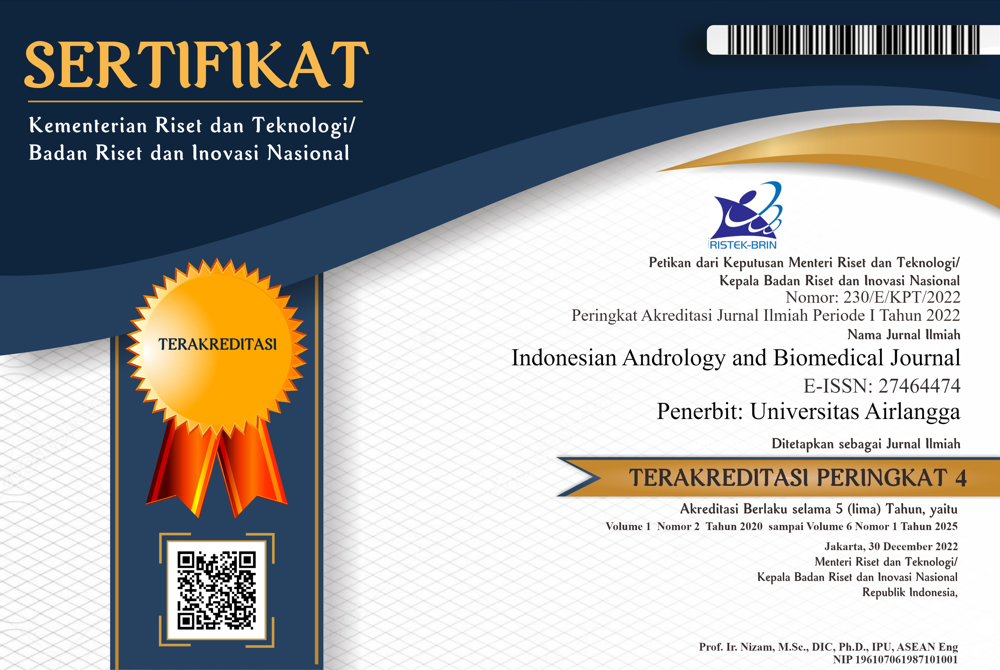Non-obstructive Azoospermia in Male with Y-Chromosome Microdeletion: A Case Report
Downloads
Male factors have contributed to at least 50% of all infertility cases worldwide. Numerous factors causing male infertility have been identified, one of which is azoospermia due to genetic defects. The detection of Y-chromosome microdeletion may assist in diagnosing male infertility as well as predicting the success rate of testicular sperm extraction. A man in his mid-thirties visited the Andrology outpatient clinic at Dr. Soetomo General Hospital accompanied by his wife. They have been married for eight years and have had regular unprotected sexual intercourse, but pregnancy has never been achieved. The patient’s semen analyses showed azoospermia in three examinations conducted at different times. Follicle-stimulating hormone (FSH) and luteinizing hormone (LH) were significantly increased, and genetic screening showed microdeletion in the Azoospermia Factor b (AZFb) subregion. Y-chromosome microdeletion is the second most common genetic defect causing azoospermia after Klinefelter syndrome. The AZF region in the distal part of the Y chromosome plays a key role in regulating spermatogenesis. Mutation or loss of any subregions in this factor may affect spermatogenesis, with the worst outcome being azoospermia. Detailed examinations are important to determine the cause of azoospermia, which may assist a physician in choosing the appropriate management for this condition. Infertile men with Y-chromosome microdeletion face challenges in reproducing naturally. They may also need genetic counseling regarding the possibility of passing on this genetic defect to their offspring and information on how to prevent it.
Agarwal A, Mulgund A, Hamada A, Chyatte MR. A unique view on male infertility around the globe. Reproductive Biology and Endocrinology. 2015 Dec 12;13(1).
Agarwal A, Majzoub A, Parekh N, Henkel R. A schematic overview of the current status of male infertility practice. Vol. 37, World Journal of Men’s Health. Korean Society for Sexual Medicine and Andrology; 2019.
Andrade DL, Viana MC, Esteves SC. Differential diagnosis of azoospermia in men with infertility. Vol. 10, Journal of Clinical Medicine. MDPI; 2021.
Chiu YH, Edifor R, Rosner BA, Nassan FL, Gaskins AJ, Mínguez-Alarcón L, et al. What Does a Single Semen Sample Tell You? Implications for Male Factor Infertility Research. Am J Epidemiol. 2017 Oct 15;186(8):918–26.
Leushuis E, Van Der Steeg JW, Steures P, Repping S, Bossuyt PMM, Blankenstein MA, et al. Reproducibility and reliability of repeated semen analyses in male partners of subfertile couples. Fertil Steril. 2010 Dec;94(7):2631–5.
Cerván-Martín M, Castilla JA, Palomino-Morales RJ, Carmona FD. Genetic landscape of nonobstructive azoospermia and new perspectives for the clinic. Vol. 9, Journal of Clinical Medicine. MDPI; 2020.
Pandiyan N, Khan SD. A clinical approach to male infertility. In: Male Infertility: A Clinical Approach. Springer India; 2016. p. 41–54.
Chen SW, Chen CP, Chern SR, Kuo YL, Chiu CL. The significance of karyotyping and azoospermia factor analysis in patients with nonobstructive azoospermia or oligozoospermia. Taiwan J Obstet Gynecol. 2022 Sep 1;61(5):800–5.
Sha J, Huang G, Zhang B, Wang X, Xu Z, Zhai J. Chromosomal abnormalities and Y chromosome microdeletions in infertile men with azoospermia and oligozoospermia in Eastern China. Journal of International Medical Research. 2019;48(4).
WHO WHO. WHO laboratory manual for the examination and processing of human semen Sixth Edition. 2021.
Arumugam M, Shetty DP, Kadandale JS, Kumari SN. Y chromosome microdeletion and cytogenetic findings in male infertility: A cross-sectional descriptive study. Int J Reprod Biomed. 2021;19(2):147–56.
Cioppi F, Rosta V, Krausz C. Genetics of azoospermia. Vol. 22, International Journal of Molecular Sciences. MDPI AG; 2021.
Chabchoub I, Kdous M, Zhioua F, Gaied A, Merdassi G. Y chromosome microdeletions screening in Tunisian infertile men. Ann Biol Clin (Paris). 2019;77(5):517–23.
Tao Y. Endocrine aberrations of human nonobstructive azoospermia. Vol. 24, Asian Journal of Andrology. Wolters Kluwer Medknow Publications; 2022. p. 274–86.
Luo H, Huang Y, Han M, Pang Y, Yu P, Tang Y, et al. Associations of serum estradiol level, serum estrogen receptor-Alpha level, and estrogen receptor-Alpha polymorphism with male infertility: A retrospective study. Medicine (United States). 2021 Jul 23;100(29):E26577.
Yuen W, Golin AP, Flannigan R, Schlegel PN. Histology and sperm retrieval among men with y chromosome microdeletions. Vol. 10, Translational Andrology and Urology. AME Publishing Company; 2021. p. 1442–56.
Esteves SC. Clinical management of infertile men with nonobstructive azoospermia. Vol. 17, Asian Journal of Andrology. Wolters Kluwer Medknow Publications; 2015. p. 459–70.
Krausz C, Hoefsloot L, Simoni M, Tüttelmann F. EAA/EMQN best practice guidelines for molecular diagnosis of Y-chromosomal microdeletions: State-of-the-art 2013. Vol. 2, Andrology. 2014. p. 5–19.
Rabinowitz MJ, Huffman PJ, Haney NM, Kohn TP. Y-chromosome microdeletions: A review of prevalence, screening, and clinical considerations. Application of Clinical Genetics. 2021;14:51–9.
Westlander G. Utility of micro-TESE in the most severe cases of non-obstructive azoospermia. Ups J Med Sci. 2020 Apr 2;125(2):99–103.
Zhang YS, Dai RL, Wang RX, Zhang ZH, Fadlalla E, Liu RZ. Azoospermia factor microdeletions: Occurrence in infertile men with azoospermia and severe oligozoospermia from China. Andrologia. 2014;46(5):535–40.
Copyright (c) 2024 Jesselyn Angellee, Agustinus Agustinus, Pety Narulita, Markus Christian Hartanto, William William, Sally Suharyani

This work is licensed under a Creative Commons Attribution-ShareAlike 4.0 International License.

















